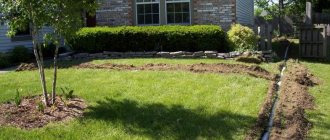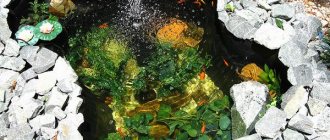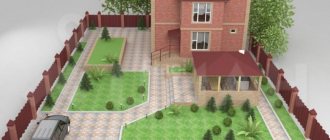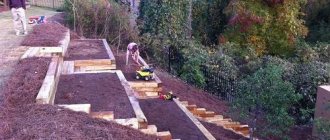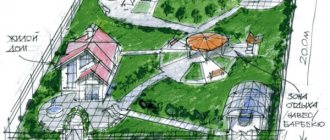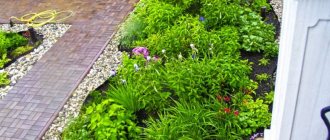The site, or part of it, is leveled for three reasons: construction, arrangement of sites and paths, laying out a lawn or vegetable garden. In the first two cases, it is not the site itself that is leveled, but the building “spot”, from which the fertile layer is first removed from the entire area. When laying out a lawn (or vegetable garden), the fertile layer must be preserved and conditions must be created to protect it from erosion and waterlogging.
Why is alignment needed?
Landscaping the site, planting plants or constructing auxiliary structures require leveling the surface. Any irregularities bring many problems:
- Rainwater will accumulate in one place and deep puddles will appear. They will provoke siltation of the soil and create a threat of flooding the foundation of the house.
- Garden beds will receive different amounts of water. For some, the moisture will immediately go to the lower levels, for others the amount of water will become excessive.
- If the slope is large enough and the soil in the area is clayey, the water will not linger at all and will immediately begin to flow down the slope.
In addition to these factors, there is one more, the simplest one - on a level surface it is easier and more convenient to carry out any work - household, gardening, construction. Even the usual installation of a garden bench requires leveling the site. If the plans include the construction of more serious structures - a bathhouse or a barn, leveling will be one of the first stages of the work.
Lumps and other irregularities make any work on the site difficult Source remontnik.ru
Immediately after building the house, they begin planning the remaining area of the site. This is done because it is much more difficult to build on a treated surface - after the first rain, the site is covered with a layer of dirt, making work difficult. If the terrain allows, it is easier to complete construction first and then level the area.
Why do you need to level the area?
Leveling the ground may be necessary in several cases:
- if there is a clearly expressed bias in any direction;
- when the area is swampy or is in a lowland (floodplain);
- if there are a lot of old trees or stumps on the site that require uprooting;
- in the presence of irregularities: potholes, potholes, embankments;
- when preparing land for construction;
- for the construction of a lawn, vegetable garden or garden.
The slope indicator is usually expressed as a percentage: 1% means 1 cm of slope for each linear meter of length. The site is rarely leveled to the “zero level” relative to the horizon - usually for pouring a foundation slab or arranging a sports ground. In all other cases, paths and hard-surfaced areas are made level, but with a slight slope from buildings to storm sewer receivers and drainage channels. The slope is at least 1%.
The planning of the area for a lawn and garden should be carried out in such a way as to prevent stagnation of rainwater and waterlogging. For example, it is recommended to make a lawn on clay soil with a slope of at least 0.5%, but not more than 11%, to avoid washing out the fertile layer.
A classic lawn, unlike a vegetable garden, requires an almost perfectly flat surface. Otherwise, in a large space sown with grass, all the bumps and holes will be clearly visible, which will not add beauty to the landscape. Therefore, when preparing an area for a lawn, leveling is recommended to be carried out in two stages: primary roughing in the fall and final in the spring.
If geological studies have shown a high level of groundwater, then, along with leveling, it may be necessary to raise the entire area. This is done by adding sand and gravel mixture and adding fertile soil in places where future plantings are planned.
Mechanical or manual method
The choice of technique depends on the size and condition of the surface of the area. Typically, for small areas (4-6 acres) manual leveling is chosen, and for larger plots (6-12 acres or more) they use machinery.
For manual surface treatment, simple tools available to any user are used:
- rake;
- shovels of different types;
- wheelbarrow;
- wooden planks for assembling a simple harrow;
- building level, tools for measuring length, cord.
Every dacha owner has an entrenching tool for cultivating the soil. Source wd40company.eu
See also: Catalog of sites popular in the Moscow region for building a country house
To remove small irregularities, use a simple device such as a harrow. Assemble a structure that resembles an extension ladder (you can use a ready-made device). Pegs are attached to it in several rows, placed on the ground and moved along the surface. In a few passes, the unevenness disappears, and all that remains is to compact the soil. For this purpose, various devices (rollers) are used.
Another method is to pull the cord onto pegs driven into the ground so that it is positioned strictly horizontally (check with a building level). Using it as a guide, fill holes and ruts with soil and smooth the surface with a rake. Small hilly areas are removed with a shovel, and excess soil is dumped into pits. The treated surface is loose, so it must be compacted using a roller.
Hand roller Source twinviewturf.com.au
Mechanical leveling of land requires the use of various machines - tractors, cultivators and other means. The work is done much faster, but renting equipment is quite expensive. Various surface treatment techniques are used. The choice is usually determined by the condition of the site, the size of the unevenness and other factors. In addition, the purpose of leveling is taken into account - landscaping the site, or preparing the surface for planting.
Only minor surface defects - potholes, holes, small folds - are usually removed manually. This is a rather labor-intensive task that requires time and physical effort. To process large areas with large differences in elevation, various technical devices are used. Let's take a closer look at them:
Using a tractor
Using a tractor is the most effective and fastest way to level a garden plot. Large areas can be treated and serious uneven terrain can be eliminated.
Sometimes a tractor is the only possible option Source izhevsk.ru
See also: Catalog of companies that specialize in landscape work of any complexity and sale of land plots
There is a large number of attachments that are installed on a tractor and allow you to solve certain problems. Can be used:
- dump;
- scheduler;
- plow;
- harrow.
These devices are able to cope with unevenness of different heights and densities. The job takes much less time to complete than manual leveling.
However, using a tractor is not always possible. It needs to be accessible to the site and requires room for maneuvering. In addition, the use of such machines on very steep slopes is not allowed. The maximum slope value for wheeled tractors is 8-9°, and for tracked tractors – 12°. If the site has a complex configuration and is located on a steep slope, tractor operation becomes impossible.
Application of the cultivator
A cultivator is a compact machine for cultivating land. It is designed for plowing, harrowing, and working with various types of attachments. The design of the cultivator consists of an engine, a wheelset and a control handle.
Patriot cultivator Source vsebolgarki.ru
The small size of the device allows it to be used in small areas. Despite its compact size, the power of the cultivator allows it to process soil of any density.
Since it is impossible to level the ground in a small area using large equipment, using a cultivator is often the only effective way to eliminate holes and potholes. As a rule, work occurs in 2 stages:
- processing with a plow;
- compacting the surface with a roller.
It will not be possible to install large attachments on the cultivator - a blade or a harrow. This somewhat reduces the capabilities of the technique and reduces the speed of processing the area. However, there are also advantages. For example, the ability to level a small area, or a narrow strip of land.
Materials for filling
The main criterion for choosing materials for backfilling is its height. So, for example, if the required lifting height of the site is insignificant and is in the range of 30-40 centimeters, then it is better not to bother with serious volumes of excavation work and soil movement at all. You can simply buy the required amount of “fertility”, drive a tractor onto the site and quickly level everything.
Important: we do not recommend, in order to save money, to cut off the fertile layer in some abandoned area. This area will remain ownerless until you are caught in the act.
If the thickness of the leveling layer exceeds half a meter, then filling is carried out in several stages (layers).
For example, the first layer can be made with brick or concrete scrap, including large-sized ones. The so-called secondary crushed stone will be suitable for the second layer. This is a granular material obtained by crushing construction waste. Brick, concrete structures, asphalt, etc. are also used as raw materials. The finer fraction of the second layer will fill the gaps in the first and wedge it. Further, depending on the height of the bedding, you can use ASG and sand.
Important: you shouldn’t use clay as backfill (even if you have a lot of it and it’s completely free). If there is no other material, it is recommended to mix the clay with sand.
It is worth paying attention to the so-called “pit soil”. For example, there is a large construction site near your site. In any case, excavation work is being carried out there related to the excavation and disposal of soil. Disposal is always an additional cost, so the builders will be only too happy to load it onto your site, perhaps even completely free of charge and using their own transport.
Steam treatment
Before leveling the area mechanically, the top layer of soil is often steamed. This is a unique technology that performs several tasks at once. In addition to leveling, weed removal and pest control are carried out.
Watering the soil with a portable sprayer Source amazonaws.com
To do it yourself, only watering the surface with boiling water followed by raking is suitable. When using special equipment, other methods become possible:
- Large areas are treated with the help of steam machines. The depth of penetration into the soil is up to 30 cm.
- Additional processing. Sulfur or copper oxides are introduced into the soil, killing pests and unwanted microflora.
- For areas intended for greenhouses, sulfur balls are used.
Steam processing technology is not new, but is used relatively rarely due to the complexity of implementation.
Where to begin
First of all, two questions need to be resolved:
- By what principles is it determined that the site will have to be filled in in any case?
- When to backfill.
The answer to the first question.
- The selected area is located in a lowland . During the rainy season and melting snow, it is constantly flooded. High groundwater level.
- There are not only depressions and lowlands on the territory, but also heights that interfere with landscaping.
- If part of the site is swampy and does not dry out even in the summer heat.
- If the road passing through the village is higher . The same applies to neighboring areas.
- If the soil on the territory of the summer cottage is littered with : household waste, used building materials, extensive contamination with fuels and lubricants, etc.
- Strong slope.
The answer to the second question is that backfilling is best done before construction begins. Here the time of year does not matter. Sometimes there are problem areas where some buildings have already been erected. In this case, leveling processes are more difficult to carry out. But there is also a plus - from the construction, the soil selected for the foundation remains, which is used for backfilling. That is, there is a certain amount of savings. But in this article we will talk about areas where construction has not yet been carried out.
Rubbish site for private construction Source m.news.yandex.ru
Lawn leveling
To prepare the ground for a lawn, the most effective of all available methods is used. As a rule, soil is redistributed throughout the area to ensure a flat horizontal surface. A slope of up to 3° is allowed, allowing excess rain or melt water to drain. Before processing begins, a layer of turf is removed, which is subsequently mixed with chernozem and laid on the prepared area.
Rolled lawn can be laid on the prepared area Source zavlaha-zavlahy.cz
Preparing the area
Before leveling begins, it is necessary to first prepare the land for this process. First of all, it is necessary to somehow mark the boundaries of the territory. The easiest way to do this is to drive pegs into the corners of the plot of land being leveled, and then connect them with tape or rope. The next step will be to clear the ground of debris, snags, trees, bushes and temporary buildings. In general, everything that will interfere with alignment.
Marking the boundaries of the site
Already at this stage, you can do the work both with your own hands and with the help of machines suitable for this task.
If the area to be leveled is small, then simply placing pegs on its boundaries will be sufficient. If such a territory is of medium or large area, then it is necessary to further divide it into several smaller sectors. This operation is carried out only when the ground is leveled using the manual method. After all, pegs with ropes will simply interfere with the operation of large equipment. For a square plot of land, 9 identical squares are usually allocated (3 rows, 3 in each). If the area to be leveled is polygonal in shape, then additional sectors are added to them. The distinction is also made using pegs. And they are connected by a rope, which should be hung parallel to the future flat area. This will provide a rough guide for alignment.
Demarcation of an area using pegs
Briefly about the main thing
Leveling the ground on a summer cottage allows you to evenly distribute rain moisture and create a convenient area for planting plants or installing landscaping elements.
The procedure consists of distributing the soil in such a way that the potholes or pits are filled with soil removed from the convex places.
To perform the work, special equipment is used. If the unevenness is relatively small, level the surface manually. The top fertile layer of soil is first removed, which is subsequently laid on the prepared surface.
Ratings 0
How to level the ground, creating the necessary slope?
If you need to level the area so that a slight slope remains, then you need to perform certain actions.
- First you need to decide on the level of slope of the site.
- Place a stake at the lowest point of the site, and align all other stakes at the required angle.
- After this, a rope or fishing line is pulled between the stakes, and leveling is carried out along it.
If you have a cultivator, it is easier to care for the area, even if it has a slight slope. But after carrying out such work, it is imperative to remove the roots of the weed, otherwise it will interfere with leveling and the full growth of plants.
Even a significant slope can be leveled out yourself or, on the contrary, you can make a small slope so that the site has an original appearance.
Required Tools
To level the area you will need:
- water level (spirit level);
- bayonet and shovel shovels;
- wheelbarrow for removing soil and garbage;
- roulette;
- pegs;
- twine.
You can make a water level yourself.
A transparent garden hose is suitable for this role. If there is an opaque hose, clear plastic tubes are inserted into it at both ends. The operating principle of this instrument is based on the fact that the water surface in communicating vessels is located at the same horizontal level.
PROCEDURE
- Study the topography (soil type and presence of groundwater).
- Find out in which direction the water flows or stagnates.
- Clear the entire area of weeds, debris and tree roots, if any.
- Allow the soil to dry without rain for about a week.
As you can see, all of these activities are quite large and complex to carry out on your own. always ready to help you with this. The cost of filling a site with us directly depends on its area and the chosen method of work. Our company has everything to do this efficiently, quickly and at a professional level.
Feasibility
Leveling the site before sowing lawn grass mixture is necessary, since the presence of unevenness will lead to the following undesirable consequences:
- the lawn loses its attractiveness;
- bald spots appear: seeds are washed away by rain from highlands to lowlands;
- When watering, water stagnates in lowlands, causing the grass to become sick;
- the haircut is done unevenly: in the lowlands it is too long, in the hills it is almost “zero”. If there are significant differences in height, cutting is generally impossible - there is a risk of damaging the lawn mower;
- injury hazard. When children frolic in outdoor games, they often run onto the lawn, and if it is strewn with bumps, falls are inevitable.
They also resort to leveling the site if it is planned to:
- setting up a vegetable garden;
- pool installation;
- building a house or fence.
At the same time, one should be aware of the high labor intensity of such work.
If you do not plan to create objects, it would be wiser to resort to an easier method:
- hide unevenness by planting a flower bed;
- plant berry bushes, for example, currants: this will also make the relief less noticeable;
- beat up the irregularities by arranging a decorative pond, a rock garden, or a corner decorated in a fairytale style.
Useful tips
Some expert advice for proper leveling of the site.
- The places where it is planned to plant green spaces are filled with sand. For vegetable and fruit crops, the layer of sand should be at least 30 cm. For flower beds and lawns, it is enough to lay out a sand layer of 15 cm.
- Crushed stone is poured under vehicle platforms, under access roads and under paths. The material is expensive, so they buy recycled crushed stone. It is a building material granules that are obtained by crushing disassembled building structures. The granular material contains asphalt, brick, concrete structures, etc.
- Under car areas and access roads, 20-40 mm crushed stone fractions are used for backfilling, and 5-20 mm fractions are used for backfilling under paths.
- Many people make the mistake of using clay for filling. The density of the material does not allow water to pass through. Therefore, there is a risk of the area becoming swampy. If there is no other building material, then clay must be mixed with sand.
- Some specialists lay geotextiles between the backfill layers. The material prevents the layers from mixing. But its expensive installation is not always suitable for the materials used for filling.
